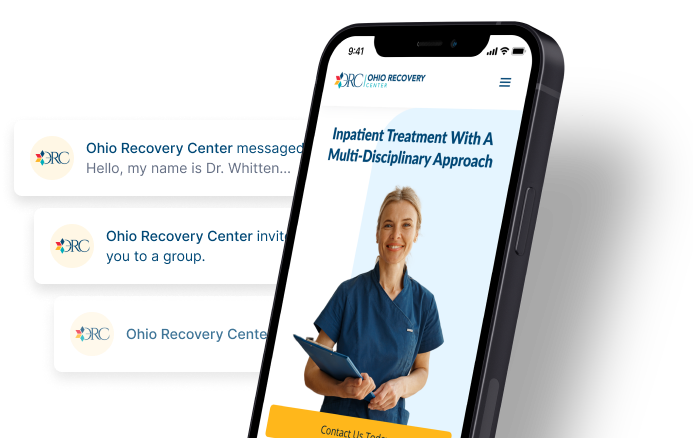Alcohol Use Disorder (AUD) In Ohio | What Is AUD?

Medically Reviewed By: Davis Sugar, M.D.
Also known as alcohol addiction or alcoholism, alcohol use disorder (AUD) is a medical condition caused by a pattern of heavy drinking on a regular basis over a prolonged period of time. If you or a loved one struggles with alcohol use disorder, help is available.

Alcohol is a habit-forming drug with a vast range of short-term and long-term effects.
One of these potential effects is alcohol use disorder (AUD), a medical condition also known as alcohol addiction or alcoholism.
What Causes Alcohol Use Disorder?
AUD is caused by a pattern of heavy drinking on a regular basis over a prolonged period of time.
Long-term exposure to high levels of alcohol causes the brain to begin to rely on alcohol to maintain your internal chemical and mental balance.
This effect is known as alcohol dependence, a condition that can trigger uncomfortable or even life-threatening withdrawal symptoms if an alcohol-dependent person stops drinking suddenly.
Along with physiological dependence, the effects of alcohol may also trigger mental and behavioral changes as drinking becomes habitual and associated with feelings of pleasure, comfort, or escape.
Alcohol Use Disorder Risk Factors
Anyone can develop an AUD, regardless of gender, age, ethnicity, religion, body type, or social class. However, there are certain factors that increase the likelihood that a person may develop an AUD, including:
- frequent binge drinking (consuming five or more drinks on an occasion for men, or four or more drinks on an occasion for women)
- a family history of alcohol abuse or other substance use disorder
- mental health problems, including bipolar disorder, anxiety, depression, or PTSD
- experiencing a high-level of stress or personal trauma
- childhood exposure to heavy alcohol consumption
- drinking alcohol early as an adolescent or young adult
- spending a lot of time with people who have excessive drinking habits
Symptoms Of Alcohol Use Disorder
An AUD will likely impact every part of your life, including your relationships, mental health, behavior, physical health, and day-to-day activities.
In fact, these common and predictable effects are outlined in the Diagnostic and Statistical Manual of Mental Disorders, Fifth Edition (the DSM-5), and are used to diagnose an AUD and evaluate its severity.
Key effects and symptoms of alcohol use disorder include:
- you have tried to stop drinking or cut back on the amount you drink, but you haven’t been able to stick with it
- you drink more or longer than you plan to
- you have difficulty thinking clearly or concentrating on things because you want to drink
- you spend a lot of time getting alcohol, drinking alcohol, and recovering from hangovers
- drinking interferes with your daily experience at home, work, or school
- you have given up important obligations or former passions to drink
- you drink even if it causes problems with your friends or family
- you’ve experienced alcohol withdrawal symptoms and cravings when you’ve stopped drinking
- you drink despite understanding that it is harming your mental or physical health
- because of tolerance, you have to drink more than you used to
- you’ve participated in risky behavior while drunk, including high-risk sex, fighting, or drunk driving
Learn more about the Alcohol Side Effects
Alcohol Use Disorder Risks
The short- and long-term risks and health conditions linked with alcohol use disorder are severe and varied. Some of the most important consequences to consider include:
Risk Of Severe Injury Or Death
AUDs are strongly associated with alcohol-related deaths and severe or lasting injuries, which can be caused by motor vehicle accidents, homicides, suicide, and alcohol poisoning/overdose.
Legal Or Financial Jeopardy
As with other forms of substance abuse, AUD greatly increases a person’s risk of legal problems, arrest, and committing or being a victim of violent crime.
An alcohol problem also makes it harder to find or keep a decent job, endangering a person’s or family’s financial security.
Increased Cancer Risk
Excessive alcohol intake is linked with an increased risk of developing a variety of different types of cancer, including mouth, throat, liver, esophagus, colon and breast cancer.
Birth Defects
Drinking any amount of alcohol during pregnancy increases a woman’s risk of miscarriage, as well as a child’s risk of fetal alcohol syndrome, which involves irreversible physical and developmental effects.
Liver & Organ Problems
Heavy alcohol consumption is a major risk factor for liver disease, including fatty liver disease, alcoholic hepatitis, and fibrosis/cirrhosis of the liver. Heavy drinking can also damage organs and bodily systems such as:
- pancreas (pancreatitis)
- bones (osteoporosis, low platelet count)
- digestive system (gastritis, stomach/esophageal ulcers)
- sexual/reproductive organs (low sperm count, erectile dysfunction, menstruation problems)
- heart (high blood pressure, heart disease, heart failure, stroke)
- immune system (increased risk and length of illness)
Neurological Issues
Problem drinking and AUDs can cause a variety of neurological problems, ranging from blackouts and short-term memory loss to a unique form of dementia.
Mental Health Problems
Even though many use it as an escape, an unhealthy reliance on alcohol worsens mental health and may trigger serious mental health conditions including sleep disorders, anxiety disorders, depression, and more.
Treatment Options For Alcohol Use Disorder
Treatment of alcohol use disorder should be personalized to fit your individual condition and needs. Common interventions and elements your healthcare provider may recommend for your treatment plan include:
Medical Detoxification
A medical detox program helps participants through alcohol withdrawal while under close medical supervision. It provides nursing care, clinical support and monitoring, and medications when necessary.
Inpatient Or Outpatient Care
After detox concludes, participants can begin rehab in either an inpatient/residential or outpatient setting, depending on preference and the severity of their condition.
Behavioral Therapy
Cognitive-behavioral therapy (CBT) and other forms of counseling can help participants understand and change certain harmful beliefs and thought patterns while building up coping mechanisms that can be crucial for long-term sobriety.
Medication-Assisted Treatment (MAT)
Certain medications have been approved by the FDA to help those in recovery from AUD, including:
- acamprosate
- disulfiram
- naltrexone
Peer Support Groups
Organizations like Alcoholics Anonymous have helped countless individuals stay accountable in recovery, offering encouragement and fellowship for anyone willing to participate.
If you or a loved one struggles with alcohol use disorder, help is available. Contact Ohio Recovery Center today for more information.
FAQ
What Is Considered Alcohol Abuse?
Forms of alcohol abuse can include excessive drinking, drinking alcohol despite a declining quality of life, and people under the age of 21 drinking alcohol in any capacity.
Learn more about Alcohol Abuse In Ohio
What Is An Alcoholic Nose?
An alcoholic nose, also known as a “whiskey nose,” is a slang term for rhinophyma, a medical condition that causes the nose to appear swollen, red, or bumpy.
Although alcohol does not cause rhinophyma, the skin condition rosacea can become irritated due to the flushing or reddening of the face when a person drinks excessively.
Learn more about Alcoholic Nose
How Dangerous Is Alcohol Poisoning?
Alcohol poisoning can be extremely dangerous for those participating in excessive alcohol consumption, which can be defined as heavy drinking and binge drinking.
Drinking large quantities of alcohol can lead to an overdose which can result in life-threatening health problems or death.
Learn more about Alcohol Overdose
How Is Binge Drinking Defined?
Binge drinking is defined as consuming at least 5 alcoholic beverages for men, or 4 alcoholic beverages for women, in a short period of time (2 hours or less). Binge drinking is viewed as a form of excessive alcohol use that can have long-term health effects.
Learn more about Binge Drinking
How Long Does Alcohol Stay In Your System?
Alcohol stays in your system for about one hour per standard drink consumed, and alcohol testing can detect alcohol use for about 72 hours after the last drink.
Learn more about How Long Alcohol Stays In Your System
What Is A Functioning Alcoholic?
A functioning or high-functioning alcoholic describes a person with an unhealthy pattern of high alcohol consumption and alcohol dependence who is still able to maintain their relationships and keep up with their daily responsibilities.
However, functioning alcoholics may still experience serious social, physical, and mental health consequences if their high alcohol consumption continues or increases long-term.
Learn more about Are You A High-Functioning Alcoholic?
What Happens To Children With Fetal Alcohol Syndrome?
Children with fetal alcohol spectrum disorders often face a wide variety of challenges that may have long-lasting effects on their overall personal health and wellbeing as adults. These can include:
- smaller size and strange appearance
- hearing, vision, or motor issues
- behavioral issues, including an increased risk of substance abuse
- problems with emotion, impulse control, hyperactivity, learning, and memory
- increased risk of mental health problems
These issues can produce lifelong challenges for those who experience FASD, especially if they are not provided with effective early treatment.
Learn more about Fetal Alcohol Syndrome In Adults
- American Psychiatric Association (APA) - Alcohol Use Disorder: A Comparison Between DSM–IV and DSM–5 https://www.niaaa.nih.gov/publications/brochures-and-fact-sheets/alcohol-use-disorder-comparison-between-dsm
- National Institute on Alcohol Abuse and Alcoholism (NIAAA) - Understanding Alcohol Use Disorder https://www.niaaa.nih.gov/publications/brochures-and-fact-sheets/understanding-alcohol-use-disorder
- Substance Abuse and Mental Health Services Administration (SAMHSA) - Medication-Assisted Treatment (MAT) https://www.samhsa.gov/medication-assisted-treatment

